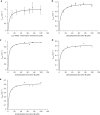Insights into a dual function amide oxidase/macrocyclase from lankacidin biosynthesis
- PMID: 30266997
- PMCID: PMC6162330
- DOI: 10.1038/s41467-018-06323-w
Insights into a dual function amide oxidase/macrocyclase from lankacidin biosynthesis
Erratum in
-
Author Correction: Insights into a dual function amide oxidase/macrocyclase from lankacidin biosynthesis.Nat Commun. 2019 Jan 29;10(1):553. doi: 10.1038/s41467-019-08571-w. Nat Commun. 2019. PMID: 30696828 Free PMC article.
-
Author Correction: Insights into a dual function amide oxidase/macrocyclase from lankacidin biosynthesis.Nat Commun. 2020 Jan 29;11(1):683. doi: 10.1038/s41467-020-14473-z. Nat Commun. 2020. PMID: 31996686 Free PMC article.
Abstract
Acquisition of new catalytic activity is a relatively rare evolutionary event. A striking example appears in the pathway to the antibiotic lankacidin, as a monoamine oxidase (MAO) family member, LkcE, catalyzes both an unusual amide oxidation, and a subsequent intramolecular Mannich reaction to form the polyketide macrocycle. We report evidence here for the molecular basis for this dual activity. The reaction sequence involves several essential active site residues and a conformational change likely comprising an interdomain hinge movement. These features, which have not previously been described in the MAO family, both depend on a unique dimerization mode relative to all structurally characterized members. Taken together, these data add weight to the idea that designing new multifunctional enzymes may require changes in both architecture and catalytic machinery. Encouragingly, however, our data also show LkcE to bind alternative substrates, supporting its potential utility as a general cyclization catalyst in synthetic biology.
Conflict of interest statement
The authors declare no competing interests.
Figures







Similar articles
-
Comparison of the 1.85 A structure of CYP154A1 from Streptomyces coelicolor A3(2) with the closely related CYP154C1 and CYPs from antibiotic biosynthetic pathways.Protein Sci. 2004 Jan;13(1):255-68. doi: 10.1110/ps.03384804. Protein Sci. 2004. PMID: 14691240 Free PMC article.
-
Cyclization mechanism for the synthesis of macrocyclic antibiotic lankacidin in Streptomyces rochei.Chem Biol. 2005 Feb;12(2):249-56. doi: 10.1016/j.chembiol.2005.01.009. Chem Biol. 2005. PMID: 15734652
-
Extensive mutational analysis of modular-iterative mixed polyketide biosynthesis of lankacidin in Streptomyces rochei.Biosci Biotechnol Biochem. 2009 Dec;73(12):2712-9. doi: 10.1271/bbb.90591. Epub 2009 Dec 7. Biosci Biotechnol Biochem. 2009. PMID: 19966473
-
Genetic and biochemical analysis of the antibiotic biosynthetic gene clusters on the Streptomyces linear plasmid.Biosci Biotechnol Biochem. 2014;78(2):183-9. doi: 10.1080/09168451.2014.882761. Epub 2014 Apr 16. Biosci Biotechnol Biochem. 2014. PMID: 25036669 Review.
-
[Polyketide antibiotics produced by polyketide synthase in streptomyces--a review].Wei Sheng Wu Xue Bao. 2009 Dec;49(12):1555-63. Wei Sheng Wu Xue Bao. 2009. PMID: 20222438 Review. Chinese.
Cited by
-
O-methyltransferase-like enzyme catalyzed diazo installation in polyketide biosynthesis.Nat Commun. 2023 Sep 4;14(1):5372. doi: 10.1038/s41467-023-41062-7. Nat Commun. 2023. PMID: 37666836 Free PMC article.
-
AvmM catalyses macrocyclization through dehydration/Michael-type addition in alchivemycin A biosynthesis.Nat Commun. 2022 Aug 3;13(1):4499. doi: 10.1038/s41467-022-32088-4. Nat Commun. 2022. PMID: 35922406 Free PMC article.
-
Biomimetic Synthesis of Chejuenolides A-C by a Cryptic Lactone-Based Macrocyclization: Stereochemical Implications in Biosynthesis.ACS Cent Sci. 2023 Jan 4;9(1):84-92. doi: 10.1021/acscentsci.2c01096. eCollection 2023 Jan 25. ACS Cent Sci. 2023. PMID: 36712486 Free PMC article.
-
Modular Chemical Synthesis of Streptogramin and Lankacidin Antibiotics.Acc Chem Res. 2021 Apr 20;54(8):1891-1908. doi: 10.1021/acs.accounts.0c00894. Epub 2021 Apr 1. Acc Chem Res. 2021. PMID: 33792282 Free PMC article.
-
Nonlinear Biosynthetic Assembly of Alpiniamide by a Hybrid cis/trans-AT PKS-NRPS.ACS Chem Biol. 2020 Apr 17;15(4):1067-1077. doi: 10.1021/acschembio.0c00081. Epub 2020 Apr 6. ACS Chem Biol. 2020. PMID: 32195572 Free PMC article.
References
-
- Weiss, A. K. H., Loeffler, J. R., Liedl, K. R., Gstach, H. & Jansen-Dürr, P. The fumarylacetoacetate hydrolase (FAH) superfamily of enzymes: multifunctional enzymes from microbes to mitochondria. Biochem. Soc. Trans. 46, 295–309 (2018). - PubMed
Publication types
MeSH terms
Substances
Grants and funding
LinkOut - more resources
Full Text Sources
Other Literature Sources
Molecular Biology Databases

